Summary
Look at the overall distribution of Net Sales in the survey.
Table: Distribution of net sales in the survey
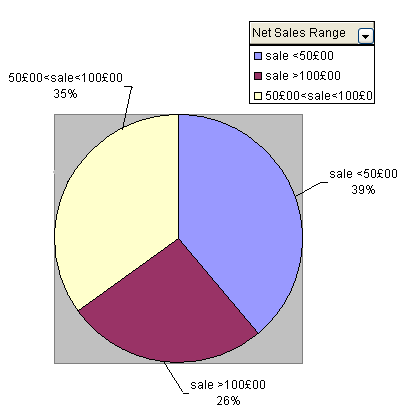
From the chart we can see that sales are almost equally distributed, with a difference of 13% between sales lower than 50£ and sales over 100£.
What is the proportion of Male/Female customers and their marital status?
Table: Distribution by gender and marital status of survey’s respondents.
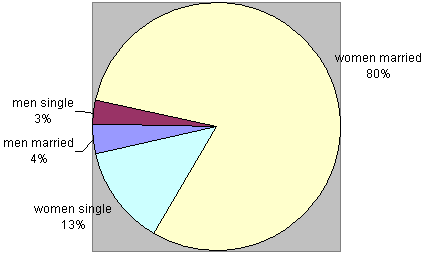
Women represent 93% of total customers, while men represent only 7% of total customers.
Married women represent the majority (80%) of the pull. Segmentation between married and single men is not very obvious, as both groups are almost equally represented (4% of total vs. 3% of total).
Which is the most frequently used method of payment by the customers?
Table: Distribution of payment methods used by the customers
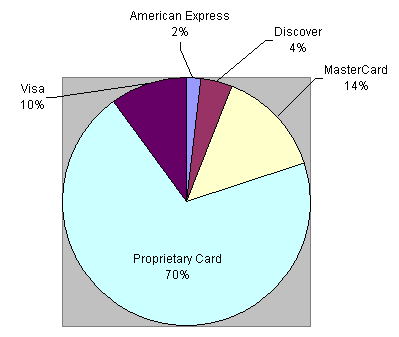
From the pie chart diagram we can see that the most frequently used payment method by customers is a proprietary card.
Is there a link between the age of the customer and his/her method of Payment?
Table: distribution of customer’s age and payment method
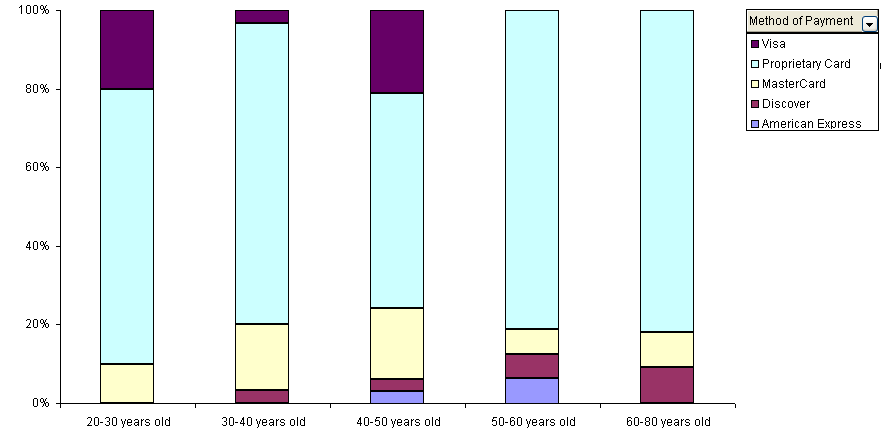
From the table we can see that the most common method of payment of customers is a proprietary card, yet we can see that among customers of 30-50 years old, the master card is a more popular method of payment than among customers older than 60 and younger than 30 (~18% vs. ~10%).
Visa card was mainly used in two age groups: 20-30 years old (20%) and 40-50 years old (21%).
Investigate whether Quality Rating is related to customer’s age
Table: Distribution of quality rating by customer’s age
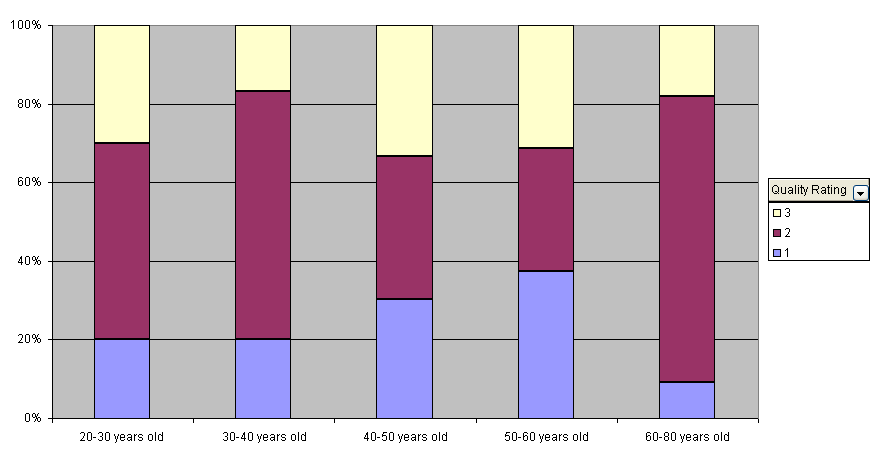
From the diagram we can see that customers in the age category younger than 40 years old rated quality higher than customers in the age category from 40 to 60 years old. Only 20% of customers in the age category 20-40 years old gave 1 point to quality vs. >30% of customers in the age category from 40 to 60 years old. The highest quality rating was given by customers in the age category from 60 to 80 years old and the lost in the age category from 40 to 60 years old.
Is there a link between the Net Sales and Quality Rating or Price and Quality Rating?
Table: Distribution of quality ration by net sales
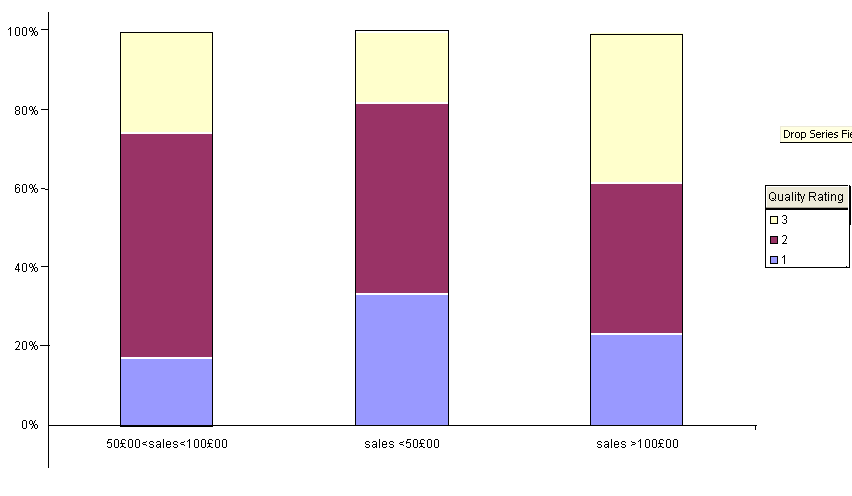
From the table above we can see that higher amount of sale implies the higher percentage of customers who gave 3 points to quality, as the percentage of people rated quality with 3 points grows from 18% for customers who purchased for the amount less than 50 GBP to 38% for customers who purchased for the amount higher than 100GBP.
Table: Distribution of quality ration by price
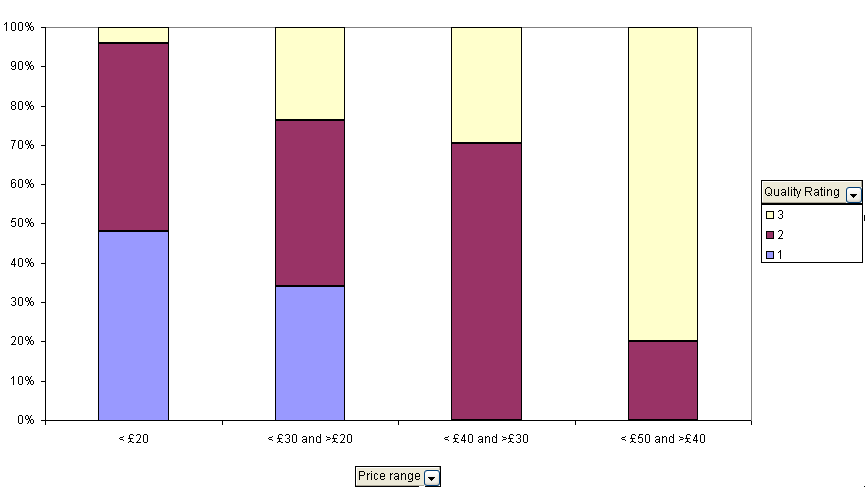
From the table above we can see that customer quality rating increases with the price of product. Customers who made purchases in the price range of 40£-50£ gave the highest quality rating: 80% gave 3 points to quality.
Examine whether the distribution of Net Sales varies by the gender and marital status of the customer
Table : Distribution of Net Sales varies by the marital status
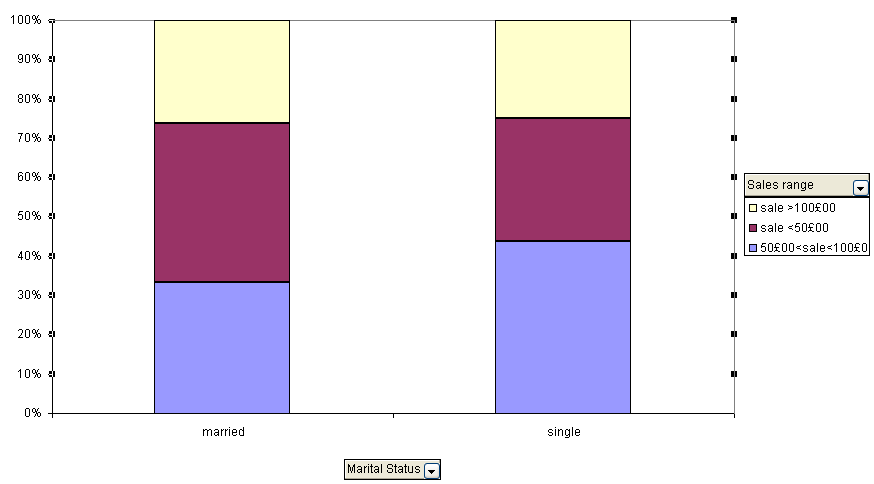
We can see from the table above that distribution of net sales doesn’t vary much by marital status. Shares of sales to single and married customers an amount higher than 100 GBP are nearly equal: 25% vs. 26%. Shares of sales to single and married customers in amounts less than 100 GBP differ only by 9% which is relatively insignificant for the whole picture of sales’ distribution.
Table: Distribution of Net Sales varies by the gender
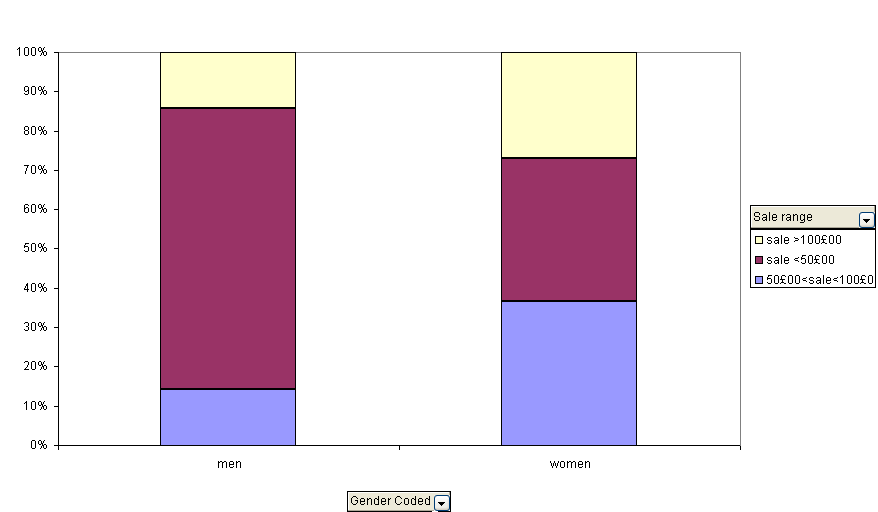
If we make a distribution by gender we will see the difference in the distribution of sales.
Men were mainly making purchases for the amount less than 50 GBP, those who purchase for the amount higher than 50 GBP and lower than 100 GBP are equally represented, forming 14% of a total number of respondents each. Sales made to women customers are nearly equally distributed between 3 “total amount” categories.
Investigate the relationship between the number of Employees and Revenue
In order to investigate and visualize the relationship of the number of employees of coffee companies and their revenues, we can use linear regression. Linear regression will allow us to approximate the data dependency provided in the task.
The linear regression equation is y= mx+b, where m is the slope and b is the interception point of the line with the y-axis.
In excel we can find the slope by applying the slope formula (=slope (dataset1; dataset2) to the sets of revenues of coffee shops and their employees. We can find interception points by applying the interception formula (=intercept (dataset1; dataset2) to the sets of revenues of coffee shops and their employees.
y=0.316516*x+1292.66
Using this equation of linear regression we can approximate revenue on the base of a number of employees in the coffee shops.
Table on base of linear regression data
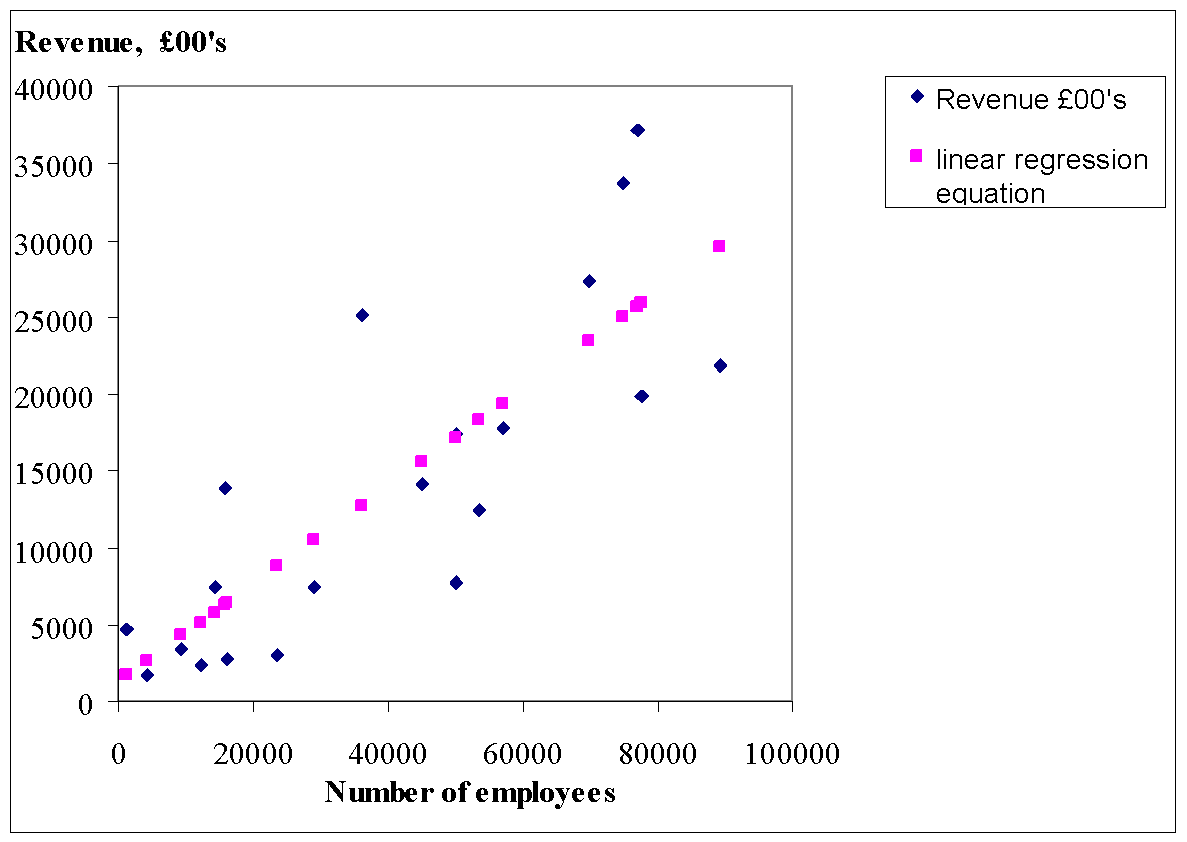
We can see from the table and from the chart (purple dots) that revenue increases with an increase on a number of employees.
Assume LCS want to increase their revenue to that of Company S how many employees should they have? Use the model to estimate this value
Also, consider the benefits/limitation of this type of analysis
We can find the number of employees LCS should have in order to achieve the revenue level of Company S from the linear regression equation for the set of data which represents how revenue varies upon the number of employees: y=0,316516*x+1292,66
We can say that linear regression can give a pretty reliable approximation, especially for the range of values which are situated close to the curve; otherwise the error of approximated value will grow. For the given set of values, we can say that for the range 4200-60000 employees’ regression analysis will be relatively accurate.
- Find some recent data on Coffee Shops in UK and present the data using a suitable table and diagram and comment.
- Discuss changes in the coffee shops in UK in this time period and your prediction of future sales of specialty coffees and/or similar products for the next 5 years
Coffee and tea are considered to be one of the most popular hot drinks in the world. It’s a well-known fact that the UK is of the biggest tea consumers per person in the world. Coffee drinking habit was always less spread in the UK, as tea is considered to be the “number one” hot drink in the country. Yet, due to marketing strategies and marketing campaigns more and more coffee supplies are entering the potential market of the UK during the last decade.
The coffee market in the UK has had a strong growing tendency over the last 10 years. There are a lot of reasons for this stable growth: the aging of the population, changes in the work environment and changes in popular culture. First of all it’s important to note that coffee consumption in UK is not relatively high, compared to consumption in other developed countries. According to the diagram from the article Coffee Statistics from E-imports, “Consumption of coffee per person in UK in the year of 2000 was 4 times smaller than in Scandinavian countries and nearly 2.5-3 times smaller than in such countries as France or Germany”.
In the research UK Coffee Sales Full Of Beans (Mitel, 2010) it is stated that people who drink coffee are mainly over 55’s and coffee drinking habit appears mainly among people who are 35 and older. This means that in the future if market tendencies do not change the number of coffee drinkers will only grow as UK population has a tendency to become older in the future. Current dynamics of the demographic situation in UK according to the UK Office for National Statistics show that “during last 25 years the number of young people reduced by 2 % (from 21% in 1984 to 19% in 2009)”. This also means that the drinking habits of elder people will have more influence on those of younger people in the future. Web resource of the UK Office for National statistics gives the following information about the change in the median age of the UK population:
“Over the past 25 years the median age increased from 35 years in 1984 to 39 years in 2009. It is projected to continue to increase over the next 25 years rising to 42 by 2034.”
The main reason why people start drinking coffee is that “together with the good taste it gives the opportunity to relax” (Mitel, 2010). Current tendencies in the UK and in the world show that in the close future people will not experience a decrease of stress, which will also affect their coffee drinking habit.
According to the article UK Coffee Sales Full Of Beans from MarketResearchWorld.net
“Economic turbulence in the UK has contributed to a shift in the way that consumers drink their coffee, which has largely been to the benefit of the in-home coffee market. As coffee shops have felt the effects of consumer belt-tightening, the in-home market has witnessed a good deal of trading up, as consumers endeavor to replicate the coffee shop experience at an in-home price. While once Brits were happy to settle with a bog-standard cup of instant, today the traditional cup of coffee has become increasingly sophisticated as roast, ground, instant premium and super-premium are being sought after more frequently by core users than in previous years.”
Another reason for the growing popularity of coffee is that coffee producers have a wide range of products to offer to customers: instant coffee, decaffeinated coffee and traditional ground coffee. Mainly instant coffee is making it popular among young working people because it takes less time to make this hot drink than tea for example.
Below is a table and chart with data on the number of coffee shops in UK per year from 2000 till 2010 (from Project Cafe Brochure, Allegra Strategies).
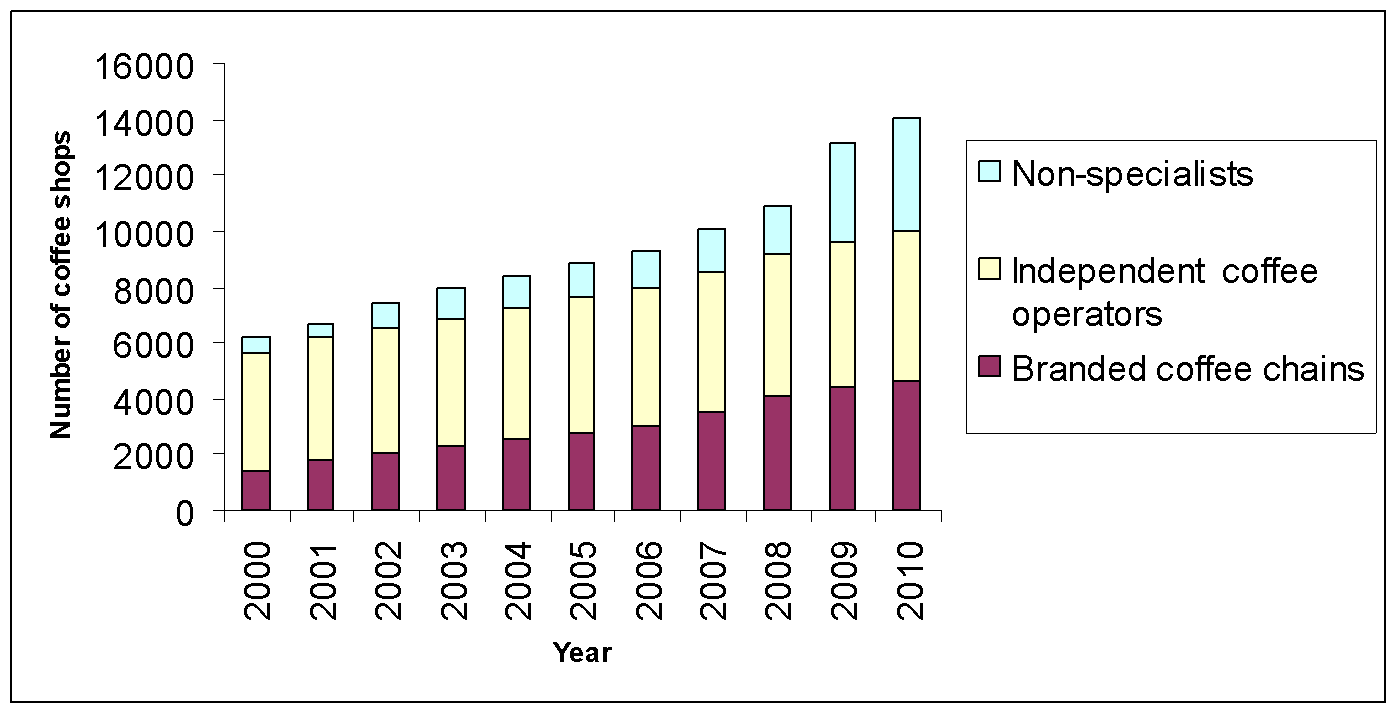
From the data in the table and shape of the diagram we can conclude that in next five years market will save a firm tendency of growth with growth rate of 5-6%. Later there can be a slight decrease in the growth of the number of coffee shops as the market will experience higher saturation.
From the data provided in the chart, we can also conclude that the growth of the number of independent coffee operators was stable during the whole period of research and was equal to ~2% per year. The growth of branded coffee chains (e.g. Starbucks) was at the rate of 6% per year. The rapid growth of coffee shops ran by non-specialists in 2008-2010 is mainly explained by current economic conditions and market preferences, as this segment of the business is more flexible.
We can see from the diagram that in the period from 2008 to 2010 non-specialist coffee outlets grew by 242% (4041 outlets in 2010 vs. 1668 outlets in 2008)
Making conclusion it’s important to say that the coffee market in the UK still has a big potential. The constant growth of coffee consumption starting from the year of 2000 will continue in the next 5 years, due to the changing drinking habits of UK customers. The popularization of coffee and the marketing strategy of the most well-known coffee brands will stimulate this growth.
References
Ageing: Fastest increase in the ‘oldest old’. Office for national statistics. n.d. Web.
Butterworth, Myra. Coffee sales rise amid economic downturn.The Telegraph. 2008. Web.
Coffee Statistics. E-imports. n.d. Web.
Euromonitor International. Coffee Shops in the UK.MarketResearchWorld. n.d. Web.
Mitel.UK Coffee Sales Full Of Beans. MarketResearchWorld. 2010. Web.
Project Café Brochure. Allegra Strategies website. 2010. Web.
Samus, Maxim. UK may face coffee sales increase.Market Leader. 2011. Web.